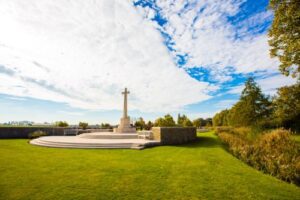 139 cemeteries and memorial sites on the former Western Front of World War One have been confirmed as the latest additions to the UNESCO World Heritage List, at the annual meeting of the World Heritage Committee on 20 September 2023. This Western Front battlefield UNESCO World Heritage sites consist of 16 in Wallonia, 27 in Flanders and 96 in France. In Flanders, some of the newly listed UNESCO sites include:
139 cemeteries and memorial sites on the former Western Front of World War One have been confirmed as the latest additions to the UNESCO World Heritage List, at the annual meeting of the World Heritage Committee on 20 September 2023. This Western Front battlefield UNESCO World Heritage sites consist of 16 in Wallonia, 27 in Flanders and 96 in France. In Flanders, some of the newly listed UNESCO sites include:
The Menin Gate – this towering gate to the city of Ypres is a memorial to the Missing Commonwealth soldiers who died in and around the Ypres Salient. Nearly 55,000 names of soldiers who have no known grave are inscribed on the memorial’s name panels. Every night at 8pm a special Last Post ceremony is held at the Menin Gate.
Tyne Cot Cemetery and Tyne Cot Memorial to the missing – located in Zonnebeke, Tyne Cot is the largest Commonwealth cemetery in the world, and the final resting place of almost 12,000 Commonwealth soldiers. The rear of the cemetery has a curved Memorial to the Missing, commemorating a further 35,000 soldiers who have no known graves.
Polygon Wood Cemetery and Buttes New British Cemetery – located at Polygon Wood, a large wood which was destroyed in the First World War, which was the site of a significant Anzac action on 26 September 1917. At the centre of Polygon Wood was a dominating mound called the ‘Butte’ which had been fortified by the Germans and used as an observation post. Resistance was heavy, but Australian soldiers took the Butte and had successfully secured the wood by the end of the day – but not without significant casualties. After the war the 5th Australian Division built its divisional memorial on the Butte in Polygon Wood. The towering obelisk overlooks CWGC Buttes New British Cemetery where more than 650 Australian soldiers are commemorated. Each year on Anzac Day (25 April) a special Dawn Service is held at Polygon Wood commemorating the efforts of the Anzacs.
Essex Farm Cemetery – this Commonwealth cemetery is the location where Lietenant-Colonel John McCrae of the Canadian Army Medical Corps wrote his famous poem ‘In Flanders Fields’ in May 1915, following the death of one of his friends to expresh his anguish and loss.
The Crypt Yser Tower – Located in the Belgian town of Diksmuide, the Yser Tower is the tallest peace monument in Europe. It houses a WWI museum in the panoramic room of the tower and a chapel, which are open to visit.

View the 27 WWI memorial UNESCO sites in Flanders here: https://www.visitflanders.com/en/discover-flanders/arts-and-heritage/flanders-fields/27-wwi-memorial-sites-flanders-fields
Mat McLachlan, Historian and founder of leading battlefield tour company, Mat McLachlan Battlefield Tours believes the inclusion of the 139 Western Front WWI sites on the UNESCO World Heritage List is an incredibly important event.
Mat McLachlan said: “The inclusion of these sites on the UNESCO World Heritage List will help to ensure their preservation for future generations. Remembering this history, and continuing to tell and share the stories of those who served – on both sides – is incredibly important to help educate about the impact of war, and it is wonderful to see these sites being internationally recognisde for their importance and significance.”
The First World War was fought from 1914 to 1918. The war came to Flanders – the Dutch-speaking northern portion of Belgium, bordering the northernmost part of France – in October 1914. During the four years of WWI, over a million soldiers from 50 different nations fought in Flanders creating a landscape of memory which continues to dominate this small corner of Belgium.
Australian troops joined the forces on the Western Front in 1916. Over 295,000 Australians served on battlefields of Flanders and France between March 1916 and November 1918. Of those, over 130,000 were wounded and 46,000 lost their lives. Battle conditions were so dire that more than 18,000 of the fallen had no known grave.
During WWI, Australian battalions served on the frontlines throughout Flanders and this region was the site of the bloodiest battle in our nation’s history – the Battle of Passchendaele.
Today, the Western Front is our nation’s most-visited historic battlefield, with thousands of Australians travelling to France and Belgium every year to honour the Anzacs. Flanders is a rich, vibrant place to visit inviting guests to explore battlefield history, the region’s medieval beginnings, culture, nature, culinary experiences and more.



















